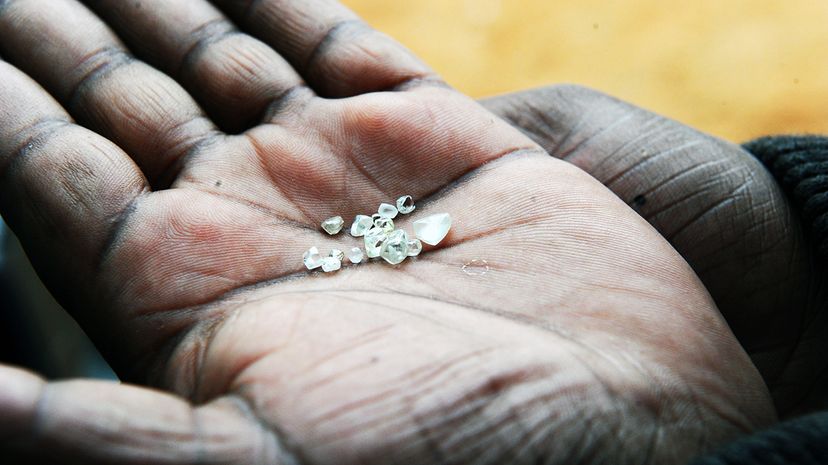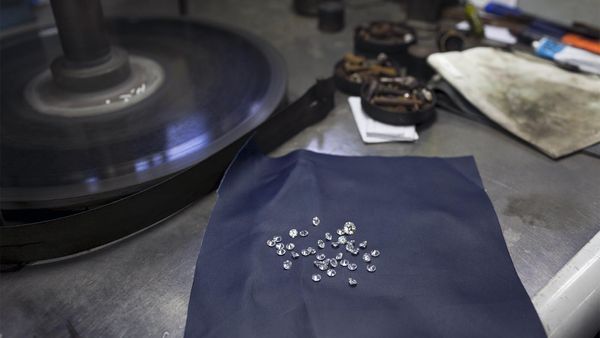
Diamonds were a girl's best friend long before Marilyn Monroe sang that iconic number in the 1953 flick "Gentlemen Prefer Blondes." But diamonds haven't always been the status symbol of love that we think of today.
In the 1930s, the diamond market had been experiencing declining sales. Due to post World War I austerity, the stones were seen by many as frivolous purchases — money down the drain. But then, something changed — and changed the world forever. Stuff They Don't Want You To Know hosts Ben Bowlin and Matt Frederick discuss what sparked that change with BrainStuff's Lauren Vogelbaum, and the three examine the often-grisly history of the stones so beloved by brides in "Diamonds: The Conspiracy".
Advertisement
Before 1870, most diamonds were mined in India and South America, and they were pretty rare. Only kings or queens had them; they just weren't for "regular" people. But then, a huge deposit of diamonds was discovered in South Africa. That's when British imperialist, Cecil Rhodes, moved in and started buying up all the property he could, including a farm owned by two brothers named de Beer. Several owners of smaller diamond mines joined up with the owners of larger mines to create a consortium called the De Beers Consolidated Mines, led by Cecil Rhodes. By 1888, Rhodes controlled the entire South African diamond supply.
But with control over so many diamonds, they worried about flooding the market, making the price too cheap to be worth the expense of mining them. So Rhodes controlled the supply by creating intermediaries to buy the uncut diamonds from the De Beers company, send them on to cutters and polishers, and from there on to retail jewelers to sell. De Beers controlled every step of the sale and distribution of the gems, and was able to decide how many diamonds to release, as well as set its own price points that had to be met worldwide, regardless of a jeweler's association with the De Beers diamond cartel.
That took care of the supply, but how about the demand? The diamond engagement ring wasn't even a tradition in any country before De Beers got into the diamond business. The company hired New York ad agency N.W. Ayer to basically create demand for diamonds, which they did admirably, thanks to a copywriter named Mary Frances Gerety. Since diamonds had no physical value, Gerety assigned them emotional value.
Suddenly, men didn't love their ladies if they didn't give them a huge diamond to signify the strength of their feelings. That's because in 1947, Gerety wrote the famed ad slogan "A Diamond is Forever," acknowledged today to be the greatest slogan in a century and studied even now in advertising classes.
Thanks to Gerety and the Ayer ad agency, 75 percent of brides wears a diamond ring on her finger.
De Beers has been challenged many times, like when a mine was discovered in Siberia in 1955. Instead of trying to compete with the new mine, De Beers offered to buy its supply, to incorporate it into the company's already-existing structures. These diamonds were a lot smaller than what the market wanted to buy, having always been told that the bigger, the better, but De Beers fixed that by creating the four C's system — clarity, carat, cut and color —so even smaller diamonds could cost as much as larger ones if they were "higher quality."
Eventually, the De Beers monopoly came to an end, and today diamond prices are driven by supply and demand. But the industry is still plagued with corruption. The human cost of mining diamonds claims hundreds of lives, contributes to poverty, and causes environmental devastation. And that "high price" of mining also wreaked havoc in the market around the turn of the 21st century — especially once consumers learned the sales of black market diamonds were funding terrorist militia groups.
People didn't want to buy these "blood diamonds," so the Kimberley Process was established 2000 as a sort of passport system for diamonds. It now indicates all stones countries of origin and ensures that no money generated by their sales will fund militia groups. Unfortunately, the Kimberley Process can't regulate or prevent the numerous human rights violations inherent in the diamond trade, including child labor, worker exploitation and even death.
To hear more about the entire history of the diamond trade, including what's going on today, you'll have to listen to the entire podcast. (It's worth a listen just to hear Ben's Leonardo DiCaprio impression.)
Advertisement

